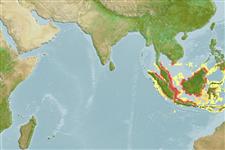Common names from other countries
Environment: milieu / climate zone / depth range / distribution range
Ecologia
marinhas; estuarina; oceanódromo (Ref. 51243); intervalo de profundidade 1 - 20 m (Ref. 6898). Tropical; 9°N - 11°S, 94°E - 126°E (Ref. 189)
Indo-West Pacific: only Penang, Malaysia in the Indian Ocean; southern Thailand to Singapore, southern Kalimantan, Java and Sulawesi. Records of this species from India refer to the rather similar Thryssa kammalensoides.
Tamanho / Peso / Idade
Maturity: Lm ? range ? - ? cm
Max length : 18.0 cm TL macho/indeterminado; (Ref. 125279); peso máx. Publicado: 36.50 g (Ref. 125279)
Espinhos dorsais (total) : 0; Espinhos anais: 0; Raios anais moles: 30 - 33. Belly with 23 to 25 (rarely 24 or 26) keeled scutes from isthmus to anus. Maxilla moderate, reaching just to gill opening or a little beyond in large fishes; first supra-maxilla about half of second. A diffuse dark `saddle' on nape.
Presumably schooling and occurring mostly inshore. More data needed based on correct identifications.
Life cycle and mating behavior
Maturities | Reprodução | Spawnings | Egg(s) | Fecundities | Larvas
Wongratana, T., T.A. Munroe and M. Nizinski, 1999. Order Clupeiformes. Engraulidae. Anchovies. p. 1698-1753. In K.E. Carpenter and V.H. Niem (eds.) FAO species identification guide for fishery purposes. The living marine resources of the WCP. Vol. 3. Batoid fishes, chimaeras and bony fishes part 1 (Elopidae to Linophrynidae). FAO, Rome. (Ref. 9822)
Categoria na Lista Vermelha da IUCN (Ref. 130435)
CITES (Ref. 128078)
Not Evaluated
Ameaça para o homem
Harmless
Utilização humana
Pescarias: pescarias de subsistência
Ferramentas
Relatórios especiais
Descarregue XML
Fontes da internet
Estimates based on models
Preferred temperature (Ref.
115969): 28.4 - 29.4, mean 29 (based on 536 cells).
Phylogenetic diversity index (Ref.
82804): PD
50 = 0.5000 [Uniqueness, from 0.5 = low to 2.0 = high].
Bayesian length-weight: a=0.00501 (0.00360 - 0.00697), b=3.12 (3.07 - 3.17), in cm Total Length, based on LWR estimates for this species (Ref.
93245).
Nível Trófico (Ref.
69278): 3.4 ±0.4 se; based on diet studies.
Resiliência (Ref.
120179): Médio, tempo mínimo de duplicação da população 1,4 - 4,4 anos (Preliminary K or Fecundity.).
Fishing Vulnerability (Ref.
59153): Low to moderate vulnerability (32 of 100).
